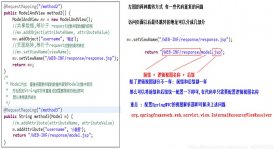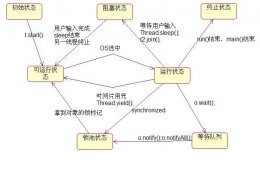Spring 校验(validator,JSR-303)实现
什么是JSR-303规范
JSR 303是Java EE 6中的一项子规范,叫做Bean Validation,官方参考实现是hibernate Validator,此实现与Hibernate ORM没有任何关系。JSR 303用于对Java Bean中的字段的值进行验证。
与Spring MVC结合
Spring-mvc.xml配置:
|
1
2
3
4
5
6
7
8
9
10
11
12
13
14
15
16
17
18
|
<!--JSR-303--><mvc:annotation-driven validator="validator"/><bean id="validator" class="org.springframework.validation.beanvalidation.LocalValidatorFactoryBean"> <property name="providerClass" value="org.hibernate.validator.HibernateValidator"/> <property name="validationMessageSource" ref="messageSource"/></bean><bean id="messageSource" class="org.springframework.context.support.ReloadableResourceBundleMessageSource"> <property name="basename" value="validatemessage"/> <property name="useCodeAsDefaultMessage" value="false"/> <property name="defaultEncoding" value="UTF-8"/> <property name="cacheSeconds" value="60"/></bean><bean id="webBindingInitializer" class="org.springframework.web.bind.support.ConfigurableWebBindingInitializer"> <property name="conversionService"> <bean class="org.springframework.format.support.FormattingConversionServiceFactoryBean"></bean> </property> <property name="validator" ref="validator"/></bean> |
实体类添加验证注解
这里贴出部分代码,知道如何加注解即可:
|
1
2
3
4
5
6
7
8
9
10
11
12
13
14
15
16
17
18
19
20
21
22
23
24
25
26
27
28
29
30
|
import com.lemontree.common.utils.AjaxResult;import com.lemontree.common.utils.StringUtil;import com.lemontree.common.utils.email.EmailUtils;import org.hibernate.validator.constraints.NotEmpty;import java.util.Date;public class User { /** * This field was generated by MyBatis Generator. * This field corresponds to the database column user.id * * @mbg.generated Thu Mar 16 13:27:38 CST 2017 */ private Integer id; /** * This field was generated by MyBatis Generator. * This field corresponds to the database column user.user_name * * @mbg.generated Thu Mar 16 13:27:38 CST 2017 */ @NotEmpty(message = "用户名不能为空") private String userName; /** * This field was generated by MyBatis Generator. * This field corresponds to the database column user.password * * @mbg.generated Thu Mar 16 13:27:38 CST 2017 */ @NotEmpty(message = "密码不能为空") private String password; } |
控制器验证注解添加
将@Validated 注解跟在实体类前面,BindingResult紧跟其后:
|
1
2
3
4
5
6
7
8
9
10
11
12
|
@RequestMapping(value = "/login.htm", method = RequestMethod.POST)public @ResponseBody AjaxResult login(@Validated User user, BindingResult bindingResult, HttpServletRequest request, HttpServletResponse response) { if (bindingResult.hasErrors()){ List<FieldError> errorses = bindingResult.getFieldErrors(); if (CollectionUtils.isNotEmpty(errorses)){ errorses.forEach(item->{ System.out.println(item.getDefaultMessage()); }); } } } |
Java Hibernate Validator JSR-303验证
JSR-303是JAVA EE 6中的一项子规范,叫做 Bean Validation,Hibernate Validator是Bean Validation 的参考实现。
实际使用就是通过注解来给字段添加约束,然后校验字段是否符合规范,如果不符合就会抛出异常,以此来减少校验数据的代码,并保证拿到的数据都是符合规范的,也可以和Spring框架配合使用
集成
官方文档
https://mvnrepository.com/artifact/org.hibernate/hibernate-validator
https://mvnrepository.com/artifact/javax.validation/validation-api
|
1
2
3
4
5
6
7
8
9
10
11
12
13
14
15
|
<dependency> <groupId>org.hibernate</groupId> <artifactId>hibernate-validator</artifactId> <version>6.0.10.Final</version></dependency><dependency> <groupId>org.glassfish</groupId> <artifactId>javax.el</artifactId> <version>3.0.1-b09</version></dependency><dependency> <groupId>javax.validation</groupId> <artifactId>validation-api</artifactId> <version>2.0.1.Final</version></dependency> |
使用
校验对象
|
1
2
3
4
5
6
7
8
9
10
11
12
13
14
15
16
17
18
19
20
21
|
public class JsrTest { @NotNull(message = "id不能为空!") @Min(value = 1, message = "Id只能大于等于1") Integer id; @NotNull(message = "姓名不能为空!") String name; public void validateParams() { Validator validator = Validation.buildDefaultValidatorFactory().getValidator();//获取一个验证器 Set<ConstraintViolation<JsrTest>> violationSet = validator.validate(this);//验证数据,获取到错误集合 Iterator<ConstraintViolation<JsrTest>> iterator = violationSet.iterator(); if (iterator.hasNext()) { String errorMessage = iterator.next().getMessage();//获取到错误信息 throw new ValidationException(errorMessage); } } public static void main(String args[]) { JsrTest req = new JsrTest(); req.id = 1; req.validateParams(); }} |
像上面那样将在属性上添加注解即可声明约束
校验属性
上面是校验整个对象,也可以单独校验某个字段:
|
1
|
validator.validateProperty(object, "name"); |
分组校验
|
1
2
3
4
5
6
7
8
9
10
11
12
13
14
15
16
17
18
19
20
21
22
23
24
25
|
public class JsrTest { @NotNull(message = "id不能为空!", groups = {ValidationGroup.class}) @Min(value = 1, message = "Id只能大于等于1") Integer id; @NotNull(message = "姓名不能为空!", groups = {ValidationGroup.class}) String name; @DecimalMin(value = "1.1") double price; int date; public static void validateParams(JsrTest jsrTest) { Validator validator = Validation.buildDefaultValidatorFactory().getValidator(); Set<ConstraintViolation<JsrTest>> violationSet = validator.validate(jsrTest, ValidationGroup.class); Iterator<ConstraintViolation<JsrTest>> iterator = violationSet.iterator(); if (iterator.hasNext()) { String errorMessage = iterator.next().getMessage(); throw new ValidationException(errorMessage); } } public static void main(String args[]) { JsrTest req = new JsrTest(); validateParams(req); } public interface ValidationGroup { }} |
分组校验所指定的calss必须是一个接口,可以指定多个
自定义约束
通常情况下,框架提供的注解已经可以满足正常的验证需求,但是我们也可以自定义注解来满足我们的需求
我们这里的例子是所注释的字符串中不能包含指定字符
|
1
2
3
4
5
6
7
8
9
10
|
@Target(FIELD) //元注解,定义该注解使用在字段上@Retention(RUNTIME) //定义注解的生命周期@Constraint(validatedBy = CustomValidator.class)//指明该注解的校验器@Documented //表示该注解会被添加到JavaDoc中public @interface CustomConstraints { String message() default "默认异常message"; Class<?>[] groups() default {}; Class<? extends Payload>[] payload() default {}; //这个属性可以用来标注错误的严重等级,但是并不被API自身所使用 String value() default " ";} |
|
1
2
3
4
5
6
7
8
9
10
11
12
13
14
15
16
17
18
19
20
21
22
23
24
25
26
27
28
29
30
31
32
|
import javax.validation.ConstraintValidator;import javax.validation.ConstraintValidatorContext;/** * 需要实现ConstraintValidator接口 * 泛型的第一个参数是自定义的注解,第二个参数注解所注释的字段的类型 */public class CustomValidator implements ConstraintValidator<CustomConstraints, String> { private String value; /** * 初始化调用,拿到注解所指定的value * * @param constraintAnnotation */ @Override public void initialize(CustomConstraints constraintAnnotation) { value = constraintAnnotation.value(); } /** * @param value 注释的字段的值 * @param context * @return true 通过验证,false 未通过验证 */ @Override public boolean isValid(String value, ConstraintValidatorContext context) { if (value != null && value.contains(this.value)) { context.disableDefaultConstraintViolation();//禁用默认的消息 context.buildConstraintViolationWithTemplate("新添加的错误消息").addConstraintViolation(); return false; } return true; }} |
然后就可以和其他注解一样使用它了
封装
或者是将验证参数的代码提取去出来,单独写一个方法
|
1
2
3
4
5
6
7
8
9
|
public static void validateParams(Object object) { Validator validator = Validation.buildDefaultValidatorFactory().getValidator();//获取一个验证器 Set<ConstraintViolation<Object>> violationSet = validator.validate(object);//验证数据,获取到错误集合 Iterator<ConstraintViolation<Object>> iterator = violationSet.iterator(); if (iterator.hasNext()) { String errorMessage = iterator.next().getMessage();//获取到错误信息 throw new ValidationException(errorMessage); }} |
当然这里也可以不抛出异常,而返回一个boolean值,如何封装看实际需求
配合Spring使用
|
1
2
3
4
5
6
7
8
|
@GetMapping("/test")public Integer lookCanBuyGoods(@Valid JsrTest req, BindingResult result) throws Exception { if (result.hasErrors()) { throw new ValidationException(result.getAllErrors().get(0).getDefaultMessage()); } //do something... return 1;} |
@Valid添加这个注解之后就会对参数进行验证,如果在其后没有跟BindingResult,验证不通过就会直接抛出异常,如果添加了BindingResult参数,就不会直接抛出异常,而会把异常信息存储在BindingResult中,供开发者自行处理
如果想要使用分组可以这样
|
1
2
3
4
5
6
7
8
|
@GetMapping("/test")public Integer test(@Validated (JsrTest.ValidationGroup.class) JsrTest req, BindingResult result) throws Exception { if (result.hasErrors()) { throw new ValidationException(result.getAllErrors().get(0).getDefaultMessage()); } //do something... return 1;} |
@Validated如果不使用分组其作用和@Valid一致
注解使用说明
| Constraint | 详细信息 |
|---|---|
| @Null | 被注释的元素必须为 null |
| @NotNull | 被注释的元素必须不为 null |
| @AssertTrue | 被注释的元素必须为 true |
| @AssertFalse | 被注释的元素必须为 false |
| @Min(value) | 被注释的元素必须是一个数字,其值必须大于等于指定的最小值 |
| @Max(value) | 被注释的元素必须是一个数字,其值必须小于等于指定的最大值 |
| @DecimalMin(value) | 被注释的元素必须是一个数字,其值必须大于等于指定的最小值 |
| @DecimalMax(value) | 被注释的元素必须是一个数字,其值必须小于等于指定的最大值 |
| @Size(max, min) | 被注释的元素的大小必须在指定的范围内 |
| @Digits (integer, fraction) | 被注释的元素必须是一个数字,其值必须在可接受的范围内 |
| @Past | 被注释的元素必须是一个过去的日期 |
| @PastOrPresent | 被注释的元素必须是过去或现在的日期 |
| @Future | 被注释的元素必须是一个将来的日期 |
| @FutureOrPresent | 被注释的元素必须是将来或现在的日期 |
| @Pattern(value) | 被注释的元素必须符合指定的正则表达式 |
| @Digits(integer =, fraction =) | 验证字符串是否是符合指定格式的数字,interger指定整数精度,fraction指定小数精度 |
| 验证是否是邮件地址,如果为null,不进行验证,算通过验证 | |
| @NotBlank | 字符串不能是Null还有被Trim的长度要大于0 |
| @NotEmpty | 不能为null,且长度大于0 |
| @Negative | 被注释的元素必须是负数 |
| @NegativeOrZero | 被注释的元素必须是负数或0 |
| @Positive | 必须是正数 |
| @PositiveOrZero | 必须是正数或0 |
以上为个人经验,希望能给大家一个参考,也希望大家多多支持服务器之家。
原文链接:https://blog.csdn.net/u012188107/article/details/72770854














